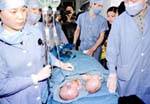 |
Chinese Hospital Separates Siamese Twins

Chinese Hospital Separates Siamese Twins
Chinese surgeons announced Wednesday that Siamese twins Tu Jian and Tu Kang have been separated after a four-hour operation, and the twins are in a stable condition.
Surgeons at the No.1 Hospital attached to the Fujian Medical University in this capital of East China's Fujian Province conducted the operation from 9:20 to 12:40.
The hospital director Lin Jianhua said the six-month old male twins were born in Changting County of Fujian on September 13 last year. Their parents Tu Rongxiang and Chen Changxiu sent them to mthe hospital on February 12 this year for an operation to separate the twins.
A team of specialists in the fields of surgery, pediatrics, oncology, orthopedics and anesthesia took part in the highly complex operation.

Chinese Hospital Separates Siamese Twins
According to the surgeons, the twins were conjoined at the abdomen from the lower breastbone to the navel at an area of 11.5 cm in length and 35 cm in diameter.
Pre-operation consultation indicated that the twins have separate hearts, lungs, digestive systems, respiratory systems, urinary systems, but their livers are connected partially.
"The six by eight cm contact area of the twins' livers is a pivotal point in the operation," Lin said. There were two major blood vessels and some intestinal canals linked together at the contact area.
But with full preparation and examination, the separation operation was conducted successfully as expected, he added.
The twins are under intensive care and the next week will be crucial to their chances of survival. They will be monitored for possible signs of post-operative infections or complications, the medical experts said.
To date, Chinese surgeons have conducted a dozen such separation operations, three were carried out in Fujian and two were reported successful.
Historical documents show that the first separation of siamese twins was in the tenth century in ancient Rome. But without professional medical treatment and anesthesia, antisepsis and transfusion, the operation failed with the death of the twins.
In 1806, a European physician separated his siamese twin daughters, with one dying from infection and the other surviving for five years.
With developments in medical technology and advancements in examination equipment, the survival rate of operations on siamese twins has largely increased to over 90 percent for one twin surviving and 53 percent for both surviving.
Over the past 50 years, hospitals worldwide have done nearly 200 separate operations on siamese twins, at least three quarters have been successful.

In This Section

|